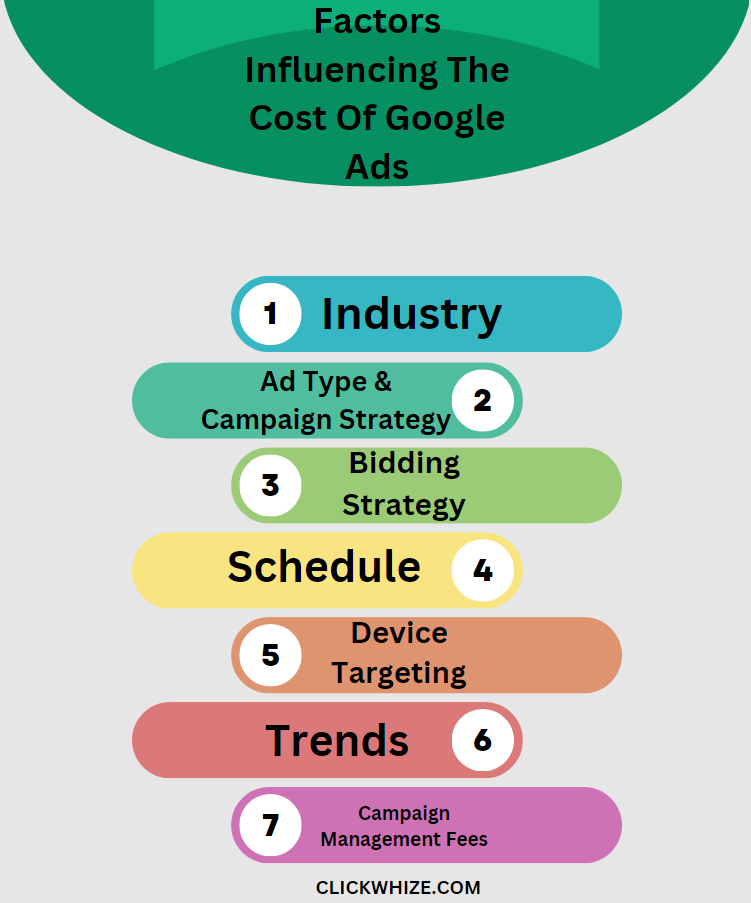How Much Do Google Ads Cost?
The enduring dilemma faced by every small business proprietor.
Responses may differ, yet it commences with grasping the identity of your customer and discerning their needs.
Are you interested in delving deeper into Google Ads costs and strategies for optimizing your ad expenditure?
Continue perusing this comprehensive Google Ads pricing guide!

Table of Contents
ToggleWhat Are Google Ads?
Google Ads, Google’s pay-per-click (PPC) platform, enables businesses to enhance their visibility across Google’s platforms.
While the search ad, prominently displayed on the search engine results page (SERP), is the most prevalent type, Google Ads accommodates a variety of ad formats including display ads, shopping ads, YouTube ads, and others, catering to diverse advertising needs.
How Much Do Google Ads Cost Per Month?
Google Ads typically range in cost from $100 to $10,000 per month.
The majority of businesses tend to pay between $0.11 and $0.50 per click, and approximately $0.51 to $1000 per 1000 impressions on average.
How Much Do Google Ads Cost Per Day?
Google suggests commencing with a daily expenditure ranging from $10 to $50.
How Much Do Google Ads Cost Per Year?
Typically, businesses allocate between $9,000 and $10,000 for Google Ads, with an average cost per click ranging from $2 to $5.
According to Amalia Fowler, a search marketing strategist, “Small businesses targeting local service areas with low competition might find $1,000 per month sufficient for ad spend, excluding service fees.”
How Much Should A Small Business Spend On Google Ads?
Initial budgets for Google Ads vary from $1,000 to $10,000.
With Google Search Ads, the typical cost-per-click falls within the range of $1 to $2.
Therefore, a $1,000 budget for Google Ads typically yields 500-1000 clicks.
Investing in Google Ads may not be worthwhile if your monthly budget falls below $1,000.
This minimum spend is necessary for testing strategies tailored to your business.
Additionally, certain industries face higher competition, resulting in increased ad costs.
What Factors Influence The Cost Of Google Ads?

It’s essential to consider the following factors as they significantly determine Google Ads pricing.
-
Industry
The industry you operate in has a direct influence on your Google Ads expenses.
On average, the cost per click (CPC) in Google Ads varies across industries, standing at $2.69 for Search and $0.63 for Display ads.
Highly competitive sectors like finance, insurance, and fitness command higher CPC rates, necessitating a substantial budget to secure prime ad placements and expand your reach in these fiercely contested markets.
CPC refers to the amount an advertiser pays for each click on their ad, determining the expense of acquiring potential customers through Google Ads.
In industries such as real estate or law, where acquiring a single client can yield significant revenue, a higher CPC may be justified to attract valuable customers.
Comparatively, B2B companies typically experience lower Google Ads costs than B2C counterparts due to their narrower focus on targeting professionals and businesses, resulting in reduced competition.
Recognizing how your industry influences your ad costs is crucial for effective campaign planning, enabling you to establish realistic cost projections.
-
Ad Type & Campaign Strategy
The expenses for Google advertising fluctuate depending on the types of ads and the strategies employed.
Here are five categories of Google Ads:
Google Search Ads
Displayed on Google’s search engine results pages (SERPs) when users query specific keywords, these ads link you with potential customers actively seeking the products or services you provide.
Google Display Ads
Visual banners are displayed throughout the Google Display Network (GDN) on a multitude of websites and applications, catering to users’ interests, demographics, or viewed content rather than their search keywords.
Google Shopping Ads
Present products in the search results through a graphical showcase, including prices and user ratings.
These advertisements afford users a swift overview of your product attributes.
Shopping ads may surface in various locations on SERPs, commonly at the top of the page but also potentially on the right-hand side.
Google Video Ads
Video advertisements on YouTube captivate viewers through visual elements, audio enhancements, and compelling narratives, whether preceding, during, or following a chosen video.
Google App Ads
Crafted to boost the visibility of mobile applications, Google’s platform facilitates the creation of ad formats seamlessly.
By furnishing essential components such as text and images, Google automates the process of generating ads tailored to promote your mobile app effectively.
These advertisements are strategically positioned across Google’s vast network, encompassing platforms like YouTube, the Google Display Network, and its search engine, maximizing exposure and outreach.
Some advertising formats, like search and display ads, might necessitate increased bidding due to their heightened competition and engagement levels.
Moreover, your campaign’s chosen strategy—be it maximizing clicks, conversions, or impressions—plays a significant role in determining expenses.
Strategies prioritizing heightened visibility during peak hours often incur greater costs.
Maintaining an equilibrium between fulfilling campaign objectives and cost management is crucial for adopting a cost-efficient approach.
-
Bidding Strategy
What are the expenses associated with Google Ads based on your bidding approach?
The cost of Google Ads is heavily influenced by your bidding strategy, which dictates the amount you allocate for user engagements such as clicks or conversions.
In Google Ads, bidding entails establishing the highest sum you’re prepared to spend on a click or other interactions, such as viewing a video ad to its conclusion.
When you bid, you participate in an ad auction to vie against other advertisers.
Bidding strategies generally fall into two primary classifications:
Manual Bidding
This feature empowers you to establish the highest allowable cost-per-click for every ad and keyword.
It’s particularly advantageous if you’ve identified which keywords generate greater clicks and conversions.
With this strategy, you can manually assign a larger budget to those high-performing keywords.
Automated Bidding
Enables Google’s algorithms to determine bids according to the probability of your ad prompting a click or conversion.
Within automated bidding, Smart Bidding employs machine learning to enhance conversions or conversion values using diverse strategies, thereby aligning bidding more effectively with your campaign objectives.
-
Schedule
The fluctuations in online traffic throughout the day or week impact the expenses associated with advertisements.
Ad scheduling, commonly referred to as dayparting, entails setting specific hours or days for displaying ads to potential customers.
This strategy allows for the optimization of budget allocation during peak periods when potential customers are most active, thereby ensuring heightened visibility and increased click-through rates.
For instance, if you operate an overnight emergency veterinary clinic, employing dayparting to target keywords like “vet near me open now” during late hours can guarantee that pet owners facing late-night emergencies encounter your advertisements.
This approach proves more cost-effective compared to running ads during peak daytime hours when numerous veterinary clinics are competing for visibility.
-
Device Targeting
Device targeting involves specifying the devices (such as mobiles, tablets, or computers) on which you want your ads to be displayed.
How does device targeting affect the cost of your Google Ads?
It primarily hinges on the user base across different devices.
A greater number of users typically translates to a lower cost-per-click (CPC) because advertisers can access a larger pool of potential customers, thereby diminishing competition.
Conversely, targeting desktop users might lead to a higher CPC due to the comparatively smaller user base.
In 2023, mobile devices accounted for 53.66% of global website traffic, whereas desktops contributed 46.34%.
We suggest examining the device usage patterns of your website visitors before finalizing your device targeting strategy for your Google Ads campaign.
This approach will help ensure that your budget is utilized effectively to reach your target audience on the devices they frequently use.
-
Trends
Multiple factors, such as heightened competition and evolving user interaction, contribute to the escalation of Google Ads expenses across diverse sectors.
Click-Through Rate (CTR) Increase
Many sectors witnessed a rise in CTR, indicating enhanced audience engagement with ads.
Yet, this uptick doesn’t necessarily translate to reduced expenses.
Heightened engagement often fosters increased advertiser competition for optimal keywords and ad spaces, potentially inflating CPC rates.
Rising Cost Per Click (CPC)
In numerous sectors, the cost per click (CPC) has surged.
This escalation in expenses can be traced back to a greater number of advertisers vying for the same keywords, indicating a heightened level of competitiveness in the advertising landscape.
To sustain visibility and efficacy, adjusting budgets to accommodate the higher CPC may be necessary.
Conversion Rate (CVR) Decline
Despite experiencing increased engagement rates, the majority of industries witnessed a decline in conversion rates.
Consequently, although more users are clicking on ads, a reduced percentage are completing the desired action, such as purchasing the product or service.
This downward trend in conversions may result in elevated costs per conversion, necessitating advertisers to enhance their ads and landing pages to achieve improved performance.
Higher Cost Per Lead (CPL)
CPL has increased across almost all sectors, suggesting that the cost of acquiring leads is on the rise.
Enhancing your targeting tactics and enhancing ad relevance are effective means to reduce CPL.
-
Campaign Management Fees
Campaign management fees encompass the costs associated with engaging a digital marketing agency or an expert to oversee your Google Ads account when you opt not to handle the campaigns independently.
These fees typically include responsibilities such as:
- Keyword research.
- Campaign setup.
- Optimization.
- Reporting.
Final Thoughts
Mastering Google Ads for small businesses is a continual challenge.
Understanding client needs is vital.
Pricing varies based on factors like competitiveness, ad type, bidding, scheduling, device targeting, and trends.
Despite Google’s daily spending recommendation, businesses usually invest thousands annually.
The online advertising landscape is dynamic, with increasing click-through rates, rising costs per click, and fluctuating conversion rates.
Vigilant campaign management is essential for optimizing expenditure and returns.
A strategic approach, whether manual or automated bidding, understanding benchmarks, or adapting to user behaviors, is vital for cost-efficient outcomes in the competitive digital marketplace.
Frequently Asked Questions (FAQs)
-
How much does it cost to run ads on Google?
The pricing of Google Ads fluctuates based on multiple factors.
On the Search Network, the typical cost per click (CPC) ranges from $1 to $2.
Meanwhile, for the Google Display Network, the average CPC falls below $1.
-
Is there a monthly charge for Google Ads?
Through Google Ads, your charges will be automatically processed on the 1st day of every month or when your balance reaches a predetermined threshold known as your payment threshold.
This charge encompasses your advertising expenses, any outstanding balance from the prior month, as well as applicable taxes and fees for certain regions.
-
Is it worth paying for Google Ads?
Put simply, platforms such as Google Ads offer highly effective PPC advertising solutions that can significantly assist in achieving various marketing objectives.
These solutions are adept at generating sales, boosting website traffic, and enhancing brand visibility, particularly when coupled with well-crafted and optimized ad content.
-
What is the average cost per 1000 impressions for Google Ads?
The typical expense for every 1000 impressions on Google Ads ranges from $0.51 to $1.00 across the Google Search Network and Google Display Network, as indicated by 56% of respondents.
-
What is the average CPC for Google Ads?
The typical cost-per-click (CPC) for Google Ads ranges from $0.11 to $0.50 across both the Google Search Network and Google Display Network, as reported by 61% of respondents.
ALSO READ: What is the Advantage of Google Ads? The Digital Secret Weapon for Marketing Success